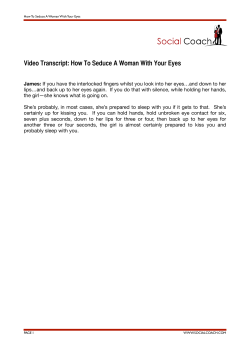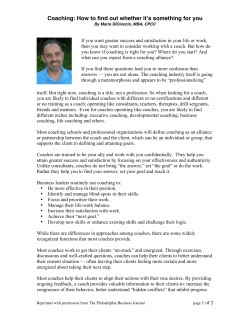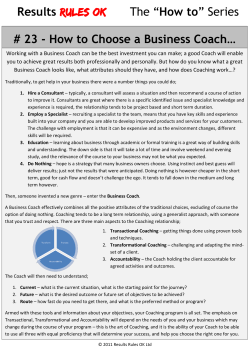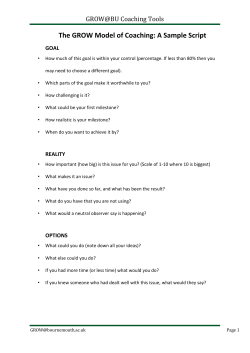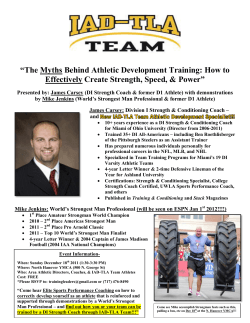
CUSP 4 MVP - VAP Coaching Manual
CUSP 4 MVP - VAP Coaching Manual Project: Funded by the Agency for Healthcare Research and Quality (AHRQ); Contract No: HHSA2902010000271 Principal Investigator: Sean Berenholtz, MD, MHS, FCCM Johns Hopkins IRB#: NA_00085530 Prepared by: Michigan Health & Hospital Association Keystone Center National Project Team: Johns Hopkins Armstrong Institute Michigan Health & Hospital Association Keystone Center Harvard Healthcare Pilgrim Institute Table of Contents Overview ....................................................................................................................................................... 3 Purpose ......................................................................................................................................................... 3 Project Players .............................................................................................................................................. 4 Communication ............................................................................................................................................. 4 Contact List for Cohort 1 ............................................................................................................................... 5 General Call Structure ................................................................................................................................... 5 Coaching Call Structure ............................................................................................................................. 6 CE-specific Coaching Calls ............................................................................................................................. 6 Coaching Call Responsibilities ....................................................................................................................... 7 Resources ...................................................................................................................................................... 8 Project Website......................................................................................................................................... 8 Additional Websites/Tools ........................................................................................................................ 8 Registration Demographics ........................................................................................................................... 8 Michigan example ..................................................................................................................................... 8 Appendices.................................................................................................................................................... 9 Appendix A – TRIP Model.......................................................................................................................... 9 Appendix B – 4 Es .................................................................................................................................... 11 Appendix C – WebEx Fact Sheet ............................................................................................................. 12 Appendix D – Sample Agendas and Notes .............................................................................................. 14 Overview Ventilator-associated events (VAE) represent a significant risk to patients that are ventilated. Based on the Center for Disease Control and Prevention (CDC) definition for VAE, approximately 23 percent of mechanically ventilated patients suffer from ventilator-associated conditions including 9.3 percent with ventilator-associated pneumonia (VAP) (Klompas et.al, 2011). This two-year project aims to implement interventions for VAP prevention including: Head-of-bed (HOB) Spontaneous Awakening Trials (SAT) Spontaneous Breathing Trials (SBT) Subglottic suctioning In addition, there are interventions specific to reducing the duration of mechanical ventilation and improving outcomes through early mobility and low tidal volume ventilation for the prevention of acute lung injury. Purpose The primary purpose of the monthly CUSP 4 MVP-VAP Coaching Call is to translate the evidence shared during the national Content Calls into usable information for frontline staff. These Coaching Calls are state-specific and will be led by your Coordinating Entity (CE) and assigned Coach. CEs and Coaches walk hospital and unit teams through the project interventions (both technical and adaptive). To help facilitate the conversations, the Translating Research Into Practice (TRIP) model, along with the 4Es (engage, educate, execute and evaluate) will be utilized as a framework for implementing the interventions. In addition to translating the evidence, we anticipate the hour-long call to include a safe space for: Networking within your state Sharing of ideas Problem solving Discussing “bright spots” Data feedback Version 1: June 25, 2014 Page 3 of 23 Project Players Armstrong Institute/ Faculty Harvard Pilgrim MHA Keystone Center Professional Organizations T UHC E P Coordinating Entity Hospital Unit Hospital Unit Unit Hospital Unit Unit Unit Hospital Unit Communication The CEs will act as the liaison between associated hospitals within their CE, the NPT, and the Coaches. Communication will be funneled to the group through the CE and tailored by the CE for their teams. Documents that may be helpful to you include: Bi-weekly Digest Content Call Schedule Facilitator Call Schedule Coaching Call Schedule Group Roster Version 1: June 25, 2014 Page 4 of 23 Contact List for Cohort 1 Coordinating Entity CE Contacts Assigned Coaches MI Phyllis McLellan: pmclellan@mha.org NJ Shannon Davila: sdavila@njha.com SC Mary Stargel: mstargel@scha.org TN Darlene Swart: dswart@tha.com TX Rachel Hardegree: rhardegree@tha.org UHC Cathy Krsek: krsek@uhc.edu Ruth Zimmerman: zimmerman@uhc.edu Amy Plotts: aplotts1@jhmi.edu Lucy Koivisto: lkoivisto@mha.org Pat Posa: posap@trinity-health.org Independents Pat Posa: posap@trinity-health.org David Thompson: dthomps1@jhmi.edu Kathleen Speck: kspeck2@jhmi.edu Sean Berenholtz: sberenho@jhmi.edu Brad Winters: bwinters@jhmi.edu Kristina Weeks: kweeks2@jhmi.edu Nishi Rawat: nrawat1@jhmi.edu Kathleen Speck: kspeck2@jhmi.edu Mayowa Ijagbemi: mijagbe1@jhmi.edu General Call Structure Outside of the Coaching Call, it is important that both CEs and Coaches attend the various calls below. This is where you will gather resources and helpful hints for your Coaching Call. Our goal is to tie in the topics from the Content Calls, the data collection from the Facilitator Calls, and helpful hints from the CE/Coach Debriefing Calls, to help enrich the discussions during your calls. Call Type Timing Facilitated By Content Calls Monthly NPT and Guest Speakers Facilitator Calls (IP, HSOPS, Data) Monthly NPT CE Call Monthly NPT Coach Debriefing Call Monthly NPT Supplemental Calls Ad-hoc, when additional content needs to be covered NPT and Guest Speakers Version 1: June 25, 2014 Page 5 of 23 Coaching Call Structure All calls will run through a WebEx platform and will be hosted by the MHA Keystone Center. The initial Coaching Call invitation will include webinar information and will be sent to CEs and Coaches. Once the CEs and Coaches log in, they will be pulled up as Panelist to facilitate the call. The PowerPoint presentation, polling questions, or additional resources should be sent to Adam Novak (anovak@mha.org) a week prior to the call, for them to be uploaded to the screen prior to the start of the webinar. CEs and Coaches can also upload information once they login. MHA will be present for technical issues, and is happy to train any/all presenters on the WebEx platform. Please see the WebEx Fact Sheet (Appendix C) for additional information. CE-specific Coaching Calls Below is an example of how your group may choose to plan and execute your Coaching Calls. Call Type Planning Call Pre-Call Coaching Call Timing Two weeks prior to the Coaching Call to formulate the agenda/slides The week of your Coaching Call to run through any last minute content changes and any data analysis Monthly based on CE’s availability Version 1: June 25, 2014 Facilitated By Coach to reach out to the CE Coach to reach out to the CE CE and Coach Page 6 of 23 Coaching Call Responsibilities Below is an example of how your group may choose to divide responsibilities between the CE, Coach, and Hospital Teams. Coordinating Entity Calls Agenda Data Content Slides Polling Questions Shares the call invite with the team and Coach MHA will host CE will facilitate Creates the agenda Reviews with Coach during pre-call (1 week prior) Sends to hospital teams (48 hrs prior) Review with the Coach during the pre-call (1 week prior) Pulls the data reports to analyze/review Reviews with Coach during planning call (2 weeks prior) and incorporates information from national Content Calls. Should be prepared to share data trends/slides from CECity reports Coach Acts as panelist and participates per the agenda Actively provides input and suggestions Actively provides input and suggestions Actively provides input and suggestions Creates and compiles the slides Sends to hospital teams (48 hrs prior) Actively provides input and suggestions Creates and reviews polling questions with the Coach Actively provides input and suggestions Hospital Teams Attends monthly calls Reviews prior to call Provides feedback to frontline staff post call Provides information to frontline staff post call Reviews prior to call Shares with frontline staff post call Answers questions during the call Comes prepared to discuss previous homework and implements new assignments with the staff Expected to actively participate during calls Homework Discussion Coordinates homework with the Coach Coordinates homework with the CE Coordinate outreach to teams that may be interested in sharing their story Support the CE in outreach to hospital teams Version 1: June 25, 2014 Page 7 of 23 Resources Project Website CUSP 4 MVP-VAP: https://armstrongresearch.hopkinsmedicine.org/cusp4mvp.aspx o CUSP Toolkit: https://armstrongresearch.hopkinsmedicine.org/cusp4mvp/toolkit.aspx o MVP Toolkit: https://armstrongresearch.hopkinsmedicine.org/cusp4mvp/mvpcare.aspx Additional Websites/Tools American Association of Critical Care Nurses (AACN): http://www.aacn.org/ o CSI Academy, hospital examples on early mobility: http://www.aacn.org/dm/csi/finalprojects.aspx?menu=csi&lastmenu= o Gap analysis tool: http://www.aacn.org/wd/practice/docs/tool%20kits/unit-gapanalysis-for-abcde-bundle.doc American Association for Respiratory Care (AARC): https://www.aarc.org/ American Physical Therapy Association (APTA): http://www.apta.org/ Association for Professionals in Infection Control and Epidemiology (APIC): http://www.apic.org/ NHSN Surveillance for VAE: http://www.cdc.gov/nhsn/acute-care-hospital/vae/index.html Society of Critical Care Medicine (SCCM) o ICU Libration Website: http://www.iculiberation.org/Pages/default.aspx o Society of Healthcare Epidemiology of America (SHEA): http://www.shea-online.org/ Vanderbilt University o ICU Delirium Website: http://www.icudelirium.org/ ICU Recovery Network (IRN) (created by Dr. Dale M. Needham (JHU) and his colleagues) o To join, email cbenne31@jhmi.edu. The Network is only for clinicians/researches, not for those who work in industry/device manufacturers. Registration Demographics If interested in learning about your group’s demographics, the below information can be pulled from the registration documents. Michigan example 7 teaching, 4 non-teaching 2 have <99 beds, 5 have 100-499 beds, and 4 have >500 beds Units involved: o 4 MICU o 3 CCU / CICU o 2 SICU o 1 CVICU / CTICU o 1 Med/Surg Version 1: June 25, 2014 Page 8 of 23 Appendices Appendix A – TRIP Model Using the TRIP Model as a Framework (taken from the CUSP 4 MVP-VAP MVP Care Toolkit) Briefly, the model is composed of four phases, listed below: 1. Develop an evidence-based intervention Identify interventions associated with improved outcomes Select interventions with the largest benefit and lowest burden 2. Identify barriers to implementation 3. Measure baseline performance 4. Ensure all patients receive the intervention Implementation of the TRIP model has been associated with significant reductions in central lineassociated blood stream infections7,8 ventilator-associated pneumonias9 in more than 100 Michigan ICUs. The results were sustained for over three years, and were associated with a reduction in mortality among Medicare patients admitted to Michigan ICUs10 and a significant cost savings for hospitals11. Implementation of the same program in Rhode Island ICUs demonstrated similar results12. Most recently, implementation of the TrIP model has been associated with significant reductions in hospitals in 45 states, including Hawaii and Connecticut13. This model will assist you in developing a method to incorporate evidence-based interventions in your patient care practices. Version 1: June 25, 2014 Page 9 of 23 Execute Evaluate Technical Adaptive Educate Technical Engage Adaptive Appendix B – 4 Es Executive Leaders Team Leaders Staff How Do I Make the World a Better Place? How do I create an organization that is safe for patients and rewarding for staff? How does this strategy fit our mission? How Do I Make the World a Better Place? How do I create a unit that is safe for patients and rewarding for staff? How do I touch their hearts? How Do I Make the World a Better Place? Do I believe I can change the world, starting with my unit? Can I help make my unit safer for patients and a better place to work? What Do I Need to Know? What is the business case? How do I engage the Board and Medical Staff? How can I monitor progress? What Do I Need to Know? What is the evidence? Do I have executive and medical staff support? Are there tools to help me develop a plan? What Do I Need to Know? Why is this change important? How are patient outcomes likely to improve? How does my daily work need to change? Where do I go for support? What Do I Need to Do? Do the Staff Know the plan and do they have the skills and commitment to implement? Have we tailored this to our environment? What Do I Need to Do? Can I be a better team member and team leader? How can I share what I know to make care better? Am I learning from defects? How Will I Know I Made a Difference? Have I created a system for data collection, unit level reporting, and using data to improve? Is the work climate better? Are patients safer? How do I know? How Will I Know I Made a Difference? What is our unit level report card? Is the unit a better place to work? Is teamwork better? Are patients safer? How do I know? What Do I Need to Do? Do the Board and Medical Staff support the plan and have the skills and vision to implement? How do I know the team has sufficient resources, incentives and organizational support? How Will I Know I Made a Difference? Have resources been allocated to collect and use safety data? Is the work climate better? Are patients safer? How do I know? © Quality and Safety Research Group, Johns Hopkins University Version 1: June 25, 2014 Page 11 of 23 Appendix C – WebEx Fact Sheet Presenter Checklist Presentation Poll Questions Supplemental Documents While creating your presentation, keep in mind the 4 E’s (Engage, Educate, Execute, Evaluate). We suggest allotting half of the presentation to cover content and half of the presentation for addressing questions and comments from the audience. Polling questions are a great way to engage the audience. If you would like to incorporate polling questions into your presentation, provide the following: questions and answer choices where during the presentation these questions should appear to the audience Supplemental documents can include any tools, worksheets, or literature that you will be referencing during your presentation and that may be useful to listeners before and/or after the presentation. Due to technical issues, we do not recommend embedding videos into the presentations. WebEx Technical Information Event Manager for Internet Explorer in Windows Event Manager for Firefox or Chrome browsers in Windows Event Center application for Mac OS X (Intel) For the WebEx Webinar platform download the installer for your operating system: WebEx Support: Notes: If you are using a non-Windows or Macintosh operating system or browser other than Internet Explorer or Firefox, a Java Client will be downloaded automatically when you join and event. For more information, go to the FAQs. You must have administrator privileges on your computer to use this installer. 1-866-569-3239 On the date of the presentation, if you have problems logging onto WebEx, please don’t hesitate to email any of the contacts listed below. We will try to assist you right away. Lucy Koivisto – lkoivisto@mha.org Adam Novak – anovak@mha.org WebEx Helpful Tips Remember to log onto the webinar first, and then call in via your phone as prompted by the WebEx pop-up window. This will ensure that your phone line and your login are connected. Both the CE and Coach will be pulled up as “panelist” during the event. If others need to be included, please let the hosts know. A practice session is available prior to the webinar to make sure all presenters are ready to speak. If interested, please let the hosts know. Once the presentation is ready to begin, the host will pass the “ball” to the presenter. At which point the presenter can advance the slides and share their screen if interested. If you would like all lines to be left open (unmated), please let the hosts know. If attendees are interested in using the chat function, we highly recommend designating a panelist to act as moderator while the CE and Coach present. Oftentimes attendees use the chat function and contact the “host” privately with questions, if this happens we will forward the message on to the appropriate contact. If using the polling question function, please anticipate time for the attendees to answers and time for the platform to calculate results once closed (additional 20 seconds). As mentioned above, embedded videos may cause technical issues. If interested in sharing a video, we recommend the presenter sharing their screen. Version 1: June 25, 2014 Page 13 of 23 Appendix D – Sample Agendas and Notes Appendix D includes sample agendas and sample notes for monthly coaching webinars. These documents are meant to supplement your agenda or provide suggestions as you prepare for your webinar. You may use, edit, and tailor this sample agenda and notes as you see fit for the hospitals and units within your own CE. Version 1: June 25, 2014 Page 14 of 23 1 CUSP 4 MVP-VAP st 1 Coaching Webinar Agenda Topic 1 Welcome/Introductions Welcome Coaching Call Purpose Phone line housekeeping announcement Introduce panelists and speakers 2 Roll Call/Attendance Read team/hospital list and ask if present Lines unmated for introductions Share role in the project 3 CUSP 4 MVP Structure/Hospital Demographics 58 National XX Hospitals 4 CUSP Team Team formation Science of safety/Unit Level Safety Assessment Leadership engagement 5 4 Es/TRIP Overview JH – What and Why Focus – How TRIP/4 E's: Measures and Interventions Review 6 Data Update HSOPS VAE Daily Process Measures Structural Assessment 7 Questions from State Teams/Content Issues Use Chat or Q&A Panel for questions Unmute lines for teams to ask questions 8 “Homework”/Upcoming Deadlines/Announcements Watch the Science of Safety video Administer the Staff Safety Assessment Facilitate a CUSP team meeting Daily Rounds to: a. Collect Process measures b. Educate staff on SAT/SBT c. Begin to identify barriers d. Walk the process e. ABCDE gap analysis Facilitator Time Allotted CE 1 minute CE 8 minutes CE 1 minute Coach 10 minutes Coach 20 minutes Coach 5 minutes CE/Coach 10 minutes CE 5 minutes Project Website: https://armstrongresearch.hopkinsmedicine.org/cusp4mvp.aspx Version 1: June 25, 2014 Page 15 of 23 1 CUSP 4 MVP-VAP st 1 Coaching Webinar Notes Topic 1 Welcome/Introductions 2 3 4 5 6 7 Welcome Coaching Call Purpose Phone line housekeeping announcement Introduce panelists and speakers Roll Call/Attendance Read team/hospital list and ask if present Lines unmated for introductions Share role in the project CUSP 4 MVP Structure/Hospital Demographics 58 National (including MI) 19 Michigan Hospitals CUSP Team Team formation Science of safety/Unit Level Safety Assessment Leadership engagement 4 Es/TRIP Overview JH – What and Why Focus – How TRIP/4 E's: Measures and Interventions Review Data Update HSOPS VAE Daily Process Measures Structural Assessment Questions from State Teams/Content Issues Use Chat or Q&A Panel for questions Unmute lines for teams to ask questions 8 “Homework”/Upcoming Deadlines/Announcements Watch the Science of Safety video Administer the Staff Safety Assessment Facilitate a CUSP team meeting Daily Rounds to: a. Collect Process measures Version 1: June 25, 2014 Facilitator Time Allotted CE 1 minute CE 8 minutes CE 1 minute Coach 10 minutes Coach 20 minutes Coach 5 minutes CE/Coac h CE 10 minutes 5 minutes Page 16 of 23 b. c. d. e. Educate staff on SAT/SBT Begin to identify barriers Walk the process ABCDE gap analysis Version 1: June 25, 2014 Page 17 of 23 2 CUSP 4 MVP-VAP 2 Coaching Webinar Agenda nd Topic Facilitator Time Allotted 1 Welcome CE Housekeeping announcements Welcome and review agenda Introduce presenters and panelists 2 Roll Call CE Complete attendance poll Read project’s hospital list for roll call 3 CUSP/Adaptive Coach Complete CUSP poll Science of safety/Staff safety assessment (SSA) Leadership engagement Learning from defects 4 Technical Interventions Coach ABCD (minus “E” at this point) o Engage – survivor story, Wes Ely presentation o Educate – sedation, delirium, HOB, SAT/SBT o Execute – listen to resisters, policies, independent checks o Evaluate – review data, define compliance targets, understand your defects 5 Data Update Coach HSOPS VAE Structural Assessment Exposure Receipt Assessment 6 Questions from State Teams/Content Issues CE/Coach Use Chat or Q&A Panel for questions Unmute lines for teams to ask questions 7 Homework/Deadlines/Announcements CE 1 minute 8 minutes 8 minutes 23 minutes 5 minutes 10 minutes 5 minutes Complete the Exposure Receipt Assessment by May 31 Join content and facilitator webinars CUSP: prioritize defects from SSA Technical: a. Continue collecting daily process measures b. Update/revise protocols c. Identify barriers and develop action plans to overcome d. Create independent checks (how will you make it easier for your staff to do the right things) e. Define education plan Project Website: https://armstrongresearch.hopkinsmedicine.org/cusp4mvp.aspx Version 1: June 25, 2014 Page 18 of 23 2 CUSP 4 MVP-VAP 2 Coaching Webinar Notes nd Topic Facilitator Time Allotted 1 Welcome CE Housekeeping announcements Welcome and review agenda Introduce presenters and panelists 2 Roll Call CE Complete attendance poll Read project’s hospital list for roll call 3 CUSP/Adaptive Coach Complete CUSP poll Did you have an executive on board? o Yes o No o I don’t know Did you educate on the Science of Safety (SOS)? o Yes o No o I don’t know Ask them share how they did this Science of safety/Staff safety assessment (SSA) Did you administer the Staff Safety Assessment (SSA)? Yes No I don’t know If yes, how did you administer this SSA? [Open box answer] o Want at least a 50% return rate o What you do with the results: Collate results Find themes Put in buckets Vote (e.g. let team pick 3) Team has to decide on which one(s) to work on Create criteria: low hanging fruit, highest risk, feasibility Leadership engagement – check current status Learning from defects – reference future call August 5 Remind of webinar: How to Run a CUSP Team - May 6 4 Technical Interventions Coach ABCD (minus “E” at this point) o Remind that the TRIP model and Gap Analysis was referenced in April o Engage – share/sample Version 1: June 25, 2014 1 minute 8 minutes 8 minutes 23 minutes Page 19 of 23 o Survivor story Wes Ely’s brain study presentation (connecting: March 4, Pain, Agitation, and Delirium (PAD) - Delirium and Sedation Management) Longer LOS, Increase readmission – helps engage senior executives Educate – what are you going to do? Sedation Assessment Sedation Assessment Guidelines RASS or SASS What assessment tools are you using? o RASS o SASS o None o Other Develop and Implement a Sedation Protocol Pre-arrange: Teams share samples of their protocols (PAD Guidelines) o If not consistent with PAD Guidelines – updated o Have to have a standard/reliable way of assessing Pain/Agitation/Delirium Do you have a pain, agitation, and delirium protocol? o Yes o No o I don’t know Delirium Tools CAM-ICU or IDSC (not in CECity) Which delirium tool are you using? o CAM-ICU o IDSC o ASE o I don’t know Coordinating SAT/SBT When are they going to do them? o E.g. SAT @ 6 a.m. and SBT @ 7 a.m. o Discuss RT & RN Coordination Do you have a protocol for SAT/SBT? o Yes o No o I don’t know Have you coordinated your SAT/SBT protocols? o Yes o No o I don’t know Are your safety screens (contraindications) consistent with the evidence? o Yes o No o I don’t know Select the appropriate exclusion criteria for SAT o Sedative infusion for active seizures or alcohol withdrawal Version 1: June 25, 2014 Page 20 of 23 o o o Fever > 101.5 o Pressor Infusion o Neuromuscular blocker administration o FiO2 > 70% o Escalating sedative doses due to ongoing agitation o PEEP >8 o Evidence of active myocardial ischemia in the previous 24 hours o Evidence of increased intracranial pressure o Other (please specify):_____ Head of Bed (HOB) Refresh teams, make sure they understand the importance E.g. some teams have included Environmental Services to help them keep an eye on the elevation Execute – Strategies to overcome barriers identified Listen to resisters Policies Pocket Cards o Pain o ABCDE o Others Posters Guidelines Web References Create independent Checks (is this happening every day?) E.g. Add ABCDE bundle to interdisciplinary rounds Standardize through Order Sets Pre-arrange: Teams share Order Sets of the PAD Evaluate – Review Data Define compliance targets (where are you going to aim?) Understand your defects Since CECity doesn’t allow for elaboration on “Others”, perhaps note those and look at those Missing Data Report (CE Level) Measuring Performance Data: Daily Process – show all pieces Performance Report Failure Criteria Share Data Collection Tools Go over measures Coach 5 minutes 5 Data Update HSOPS a. HSOPS Debriefing Call is on: May 8 VAE Structural Assessment Version 1: June 25, 2014 Page 21 of 23 a. Data/percentage complete b. Have you completed the SA? Exposure Receipt Assessment: Due May 31 6 Questions from State Teams/Content Issues CE/Coach 10 minutes Use Chat or Q&A Panel for questions Unmute lines for teams to ask questions 7 Homework/Deadlines/Announcements CE 5 minutes Complete the Exposure Receipt Assessment by May 31 Join content and facilitator webinars CUSP: prioritize defects from SSA Technical: a. Continue collecting daily process measures b. Update/revise protocols c. Identify barriers and develop action plans to overcome d. Create independent checks (how will you make it easier for your staff to do the right things) e. Define education plan Do you currently do Interdisciplinary Rounds on your unit? a. Yes, daily b. Yes, a couple times a week c. No d. I don’t know If yes, who participates in your interdisciplinary rounds? a. Physicians b. Bed side nurse c. Case Manager d. Nutritionist e. PT f. Pharmacy g. RT h. Other i. I don’t know Followup – ask to share if they have any daily goals sheets and standard work related to IDR Team progress: o Teams should know baseline and identified barriers o Teams now need to implement interventions Pre-arrange teams to share on the next webinar Documents/Tools/Resources: o Melissa Miller SAT Article Purple = questions/polling Version 1: June 25, 2014 Page 22 of 23 Evaluate Adaptive Execute Ask, how will Early Mobility make the world a better place? -Help staff understand preventable harm -Share stories about patients affected -Develop a business care -Include execute champion/physician leadership Technical Educate -Define evidence related to preventing VAEs (short and long term cognitive affects, and physical/psychological disabilities) -Share success stories, videos, or explore the IRN website during CUSP 4 MVP-VAP mtgs -Plan a site visit with experienced units/facilities -Create business case related to the impact of early mobility, including increased time off the ventilator, decreased hospital LOS and decreased ICU LOS -Share business case with executive champion/ physician leadership -Discuss Post-Intensive Care Syndrome (PICS) -Review the literature -develop mobility criteria and progressive mobility protocol/guideline -Define your education plan (utilizing workshops, hands-on trainings, conferences, slides, presentations and interactive discussions via multiple modalities to cater to different learning styles) -Identify support through outreach to the leadership team What do we need to mobilize critically ill patients? -Convert evidence into behaviors -Evaluate awareness and agreement Adaptive Engage Early Mobility How will we implement early mobility at our hospital give local culture and resources? -Listen to resisters -Standardize care and create independent checks -Make it easy to do the right thing -Learn from mistakes -What is the process for mobilizing a patient? -Is there a policy on the unit? -Who should be involved? -Do we have all the equipment? -Discuss as part of interdisciplinary rounds/daily goals -Learn from defects Technical Frontline Staff How will we know that our efforts to mobilize our patients made a difference? -Define measures -Regularly assess measures -Provide feedback to staff and celebrate success -Collect Early Mobility Daily Rounding measures and review at CUSP 4 MVP-VAP meetings -Use CECity to trend performance
© Copyright 2025




